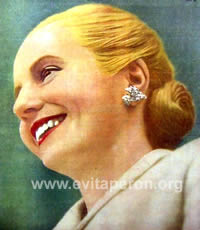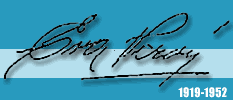 On December 30, 1949, two days before the beginning of 1950, the year dedicated to General San Martín, the Fundación Eva Perón inaugurated The "General San Martín Home for Women Employees" (Hogar de la Empleada General San Martín). Named in honor of the hero of Argentina's independence, located just a few blocks from the Plaza de Mayo on the wide tree-lined Avenida de Mayo number 869, the Home opened its doors to five hundred extremely excited and happy women. On December 30, 1949, two days before the beginning of 1950, the year dedicated to General San Martín, the Fundación Eva Perón inaugurated The "General San Martín Home for Women Employees" (Hogar de la Empleada General San Martín). Named in honor of the hero of Argentina's independence, located just a few blocks from the Plaza de Mayo on the wide tree-lined Avenida de Mayo number 869, the Home opened its doors to five hundred extremely excited and happy women.
The book "El Hogar de la Empleada" sums up the problems faced by young women who make the transition from small town to large city in search of work.
These women who come to Buenos Aires on their own "do not find even a miserable substitute of a home. Life has shown us hundreds of young women who, newspaper in hand, go directly from the train stations or ports to the city in search of work and a place to stay. In the name of progress, how many lives have been frustrated when they have just begun, how many illusions has the city atomized? It seems as though all construction involves destruction. "A young woman employee or worker seems symbolic of the crowded city. Where have we not seen her? Her face appears in millions of offices, in an infinity of hotels, in thousands of factories, behind all the counters. Her young face, marked at times by eyes prematurely aged, is found in shabby boardinghouses where people are out to cheat her, in the doorways of workshops and stores during lunch hours, in sad and solitary ramblings on weekends and holidays."1
Evita had known the loneliness of being separated from friends and family. As a struggling actress, she had lived in boardinghouses far from the city center, less expensive but more dangerous to reach once the theaters closed. She had made the choice between paying her rent or buying food. Her meager salary as an actress was reduced even more by the money she sent to help her family in Junín. One of Evita's friends, Pierina Dealessi, an actress who had her own company, remembers: "Evita was a transparent little thing... . Her hands were always cold and clammy due to her hunger, her sadness... ." 2
As Néstor Ferioli pointed out, "...Evita spoke very little about her life before she met Perón; but one can find her in her works, especially those of the Fundación, and confirm that she constructed her social work based on her own experience as a woman of the people."3
Evita's Home for Women Employees was exactly that: a home. Three conditions were necessary to qualify for admittance as one of the 500 women who lived in the Hogar de la Empleada. The employee could not have any relatives in Buenos Aires; she had to provide a police certificate of good conduct; and, at a time when the minimum wage was $300 pesos, the employee could not earn more than $500. Each employee paid a monthly fee based on her earnings and on the room she lived in (for one, two or three women).4
The Hogar was a self-contained village.
The women's bedrooms occupied nine of the twelve floors. Each suite consisted of a spacious bedroom with wide windows, a bathroom and sitting room. The nine floors was decorated in different styles: French (Louis Quinze), Provençal, Norman French, English Country, Viennese, Contemporary, etc. The brides' floor (for those soon to be married) was done entirely in white.
 The second floor had a library, a music room and a sewing room. The music room was especially elegant with its lovely curtains, crystal chandeliers, columns, mirrors and objets d'art (porcelain statues, tapestries, a Spanish mantilla thrown over the piano). Most of these objects had been given to Evita by different heads of state during her trip to Europe in 1947. Long before the time of CD's and DVD's, record players, records, and a film projector helped create a cheerful atmosphere. The second floor had a library, a music room and a sewing room. The music room was especially elegant with its lovely curtains, crystal chandeliers, columns, mirrors and objets d'art (porcelain statues, tapestries, a Spanish mantilla thrown over the piano). Most of these objects had been given to Evita by different heads of state during her trip to Europe in 1947. Long before the time of CD's and DVD's, record players, records, and a film projector helped create a cheerful atmosphere.
The sewing room was always crowded with women who wanted to learn to sew, not only to economize by making their own clothes but also to as a means of supplementing their family's finances after they married. Evita never forgot how her own mother had supported her children by sewing; the houses she built were always equipped with sewing machines as were the Hogares de Tránsito (the Temporary Homes where homeless women and children were lodged until work and more permanent living quarters could be found for them). The employees' medical and dental needs were taken care of, absolutely free-of-charge, in consulting rooms on the top floor. A solarium on the terrace, complete with comfortable chaises lounge and hammocks for sunbathing, offered the women a chance to "catch some rays" even in the midst of the big city. Small kitchens on each floor enabled them to prepare a snack, a cup of coffee, tea, or the mate so dear to Argentine hearts. A series of boutiques and small shops made it possible for the women to buy clothes and other necessities without leaving the Home.
Open from 11:00 A.M. to 2:45 P.M. and from 6:30 P.M. to 10:00 P.M., two restaurants made the Home for Women Employees almost self-supporting. One restaurant offered excellent food at very modest prices so that workers who could not go home for lunch would be able to eat a nourishing meal. A union card or employee badge gained them admittance. The other restaurant, open to the general public, also served excellent meals at reasonable prices. The Peronista legislators found it an ideal place to continue their congressional discussions over lunch. This restaurant also offered another extremely busy person who worked nearby a place to relax and enjoy a meal with friends. Often after work, Evita invited her friends and coworkers to dine with her at the Hogar de la Empleada.
In the restaurant of the Hogar de la Empleada, the Peña Eva Perón was born (a peña is simply a meeting of a group of friends who gather to sing or recite poetry). According to Fermín Chávez, a writer and historian who was a frequent participant, the first Peña Eva Perón took place on September 1, 1950. Its origins can be traced back to Evita's afternoons in the Ministerio de Trabajo y Previsión where she attended to the poor. One afternoon José María Castiñeira de Dios, a subsecretary of the Dirección General de Cultura, witnessed a scene which he never forgot. It revealed to him the depth of Evita's understanding that poverty involves more than a lack of material goods. A woman with a hideous sore on her face approached Evita to kiss her. Castiñeira, hearing a doctor comment that the wound could be syphilitic, tried to prevent the woman from coming near Evita. But Evita brushed him aside and let the woman kiss her. Castiñeira was so impressed by this gesture that he wrote a poem in which he compared Evita to the mythological pelican who nourishes its young with its own lifeblood. 5 Asked to read the poem one night, Castiñeira began a tradition in which the Peronista intellectuals shared their poems, thoughts, and, at times, speeches.
Evita was in all the details. In October, 1950, different cultural acts were being planned to commemorate the most important Peronista holiday, October 17. (In October of 1945, fearful of his growing popularity with the workers, the military had arrested Perón. All during the day of October 17, 1945, workers had streamed into Plaza de Mayo, refusing to leave until Perón was finally freed.) Castiñeira had brought the printed program of the week's cultural events to the 1950 Peña to show Evita. The most important date, October 17, when thousands of workers would again fill the Plaza, was listed as a "free day" with no events scheduled. Realizing that the labor unions would perceive this omission as a slight, she pointed it out to Castiñeira. The programs were redone with the Confederación General de Trabajo's massive gathering listed as the day's only event.6
Evita also told Juan Oscar Ponferrada, poet, writer, dramatist and director, "Ponferrada, Shakespeare's The Taming of the Shrew will be performed at the Teatro Cervantes, but as the text is very long ("frondoso"), I want you to work with Fermín Chávez to shorten it." And they did.7
 Fermín Chávez points out that the Evita he knew bore no resemblance to the Evita of the "black myth," the "woman with the whip."8 Fermín Chávez points out that the Evita he knew bore no resemblance to the Evita of the "black myth," the "woman with the whip."8
"The Evita I knew was joyful, spontaneous, with no artifice; she impressed you with her vitality [and] extraordinary memory. Her dark eyes, starbright, were what most stood out in her face. During our meals, more than once, we could confirm her extremely rapid natural intelligence and her common sense which left us speechless." During these dinners with her friends and co-workers, Evita could relax, laugh, and be herself. "I cherish in my heart," she wrote, "the pleasant memory of these meetings... ."9
By September of 1950, Evita had less than two years to live and the Golden Age of Peronism was drawing to its close. In 1955, the military staged a coup d'etat which ended Perón's presidency and sent him into exile. As with all the Fundación's works, the Hogar de la Empleada was taken over by the military and put to other uses. In an auction held behind closed doors, the "milicos" and their wives bid on the valuable objects with which Evita had adorned the Hogar. 10
The brochure printed in 1950 to explain the purpose of the Hogar de la Empleada spoke of the human cost involved in human progress: "It seems that all construction involves destruction."
Evita built; those who came after her destroyed. More than fifty-five years after Evita's death, most of the hospitals in use in Argentina today were built during the time of the Fundación Eva Perón.11
1 El Hogar de la Empleada. [Buenos Aires, Argentina]: Servicio Internacional Publicaciones Argentinas, n.d.
2 Dujovne Ortiz, Alicia. Eva Perón:A Biography. New York:Saint Martin's Press, 1995. p.40.
3 Ferioli, Néstor. La Fundación Eva Perón. Vol.1. Buenos Aires: Centro Editor de América Latina, 1990. p.150.
4 "El Hogar de la Empleada." Mucho Gusto September 1950:47.p.22
5 Navarro, Marysa. Evita. Buenos Aires: Edhasa, 2005. p.271.
6 Chávez, Férmin. Eva Perón Sin Mitos. Buenos Aires: Ediciones Theoría, 1996. p. 128.
7 Eva Perón http://usarios.lycos.es./evaperon3
8 Chávez., p. 129.
9 ibid., p. 130.
10 Ferioli, op.cit., p. 107.
11 "What is shameful for the military and the politicians who came after Perón is that the majority of the hospitals which were built in the Province of Buenos Aires and in the rest of the country are from that epoch [of the Fundación]." O'Donnel, Pacho, José García Hamilton and Felipe Pigna. Historia Confidencial. Buenos Aires: Planeta, 2006. p. 232. |





